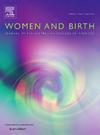Strengthening midwifery education: An Assessment of Bachelor’s degree midwifery curricula in the West Bank, occupied Palestinian territory (oPt)
IF 4.1
2区 医学
Q1 NURSING
引用次数: 0
Abstract
Problem
In 1997, the first four-year direct-entry bachelor’s midwifery program was launched in the West Bank, oPt, followed by four similar programs at other local universities. Since then, no comprehensive evaluation has been conducted to assess the quality or content of these programs.
Aim
To assess four-year direct-entry bachelor’s midwifery programs against the International Confederation of Midwives (ICM) essential competencies for midwifery practice.
Methods
A cross-sectional rapid assessment of all five direct-entry bachelor’s midwifery programs in the West Bank was conducted using a self-assessment tool comprising 92 ICM essential competencies. Data were collected by midwifery faculty members and analyzed using frequencies and percentages for each competency category based on the total number of assessed competencies.
Findings
Across the five midwifery programs, total competency scores ranged from 54.3 % to 68.5 %. Scores were observed in ongoing care of women and newborns (77.8–88.9 %) and antenatal (70.6–84.4 %). Competencies related to care during labor and birth ranged from 61.5 % to 69.2 %, while the lowest scores were in sexual and reproductive health and rights (16.7–41.7 %).
Discussion
Findings indicate that, although midwifery programs share similar core concepts, variations and gaps exist, particularly in competency coverage, with some deficiencies linked to limited clinical training opportunities and services.
Conclusion
The assessment results should guide midwifery programs in revising curricula to integrate ICM competencies, while faculty need training in pedagogy, evidence-based updates, and research skills; mentorship and capacity-building are also essential for faculty, clinical instructors, and students.
加强助产教育:西岸,巴勒斯坦被占领土(oPt)的学士学位助产课程评估。
问题:1997年,第一个四年制直接入学的助产学学士课程在西岸启动,即oPt,随后在其他当地大学也开设了四个类似的课程。从那时起,没有进行全面的评估来评估这些计划的质量或内容。目的:评估国际助产士联合会(ICM)助产实践基本能力的四年制直接入学学士助产课程。方法:使用包含92项ICM基本能力的自我评估工具,对西岸所有五个直接进入学士助产项目进行了横断面快速评估。数据由助产士教师收集,并根据评估能力的总数,使用每种能力类别的频率和百分比进行分析。研究结果:在五个助产项目中,总能力得分从54.3% %到68.5 %不等。在妇女和新生儿(77.8-88.9 %)和产前(70.6-84.4 %)的持续护理中观察得分。与分娩和分娩期间护理相关的能力范围从61.5% %到69.2% %,而得分最低的是性健康和生殖健康及权利(16.7- 41.7% %)。讨论:研究结果表明,尽管助产学课程具有相似的核心概念,但存在差异和差距,特别是在能力覆盖方面,其中一些缺陷与有限的临床培训机会和服务有关。结论:评估结果应指导助产专业修改课程,以整合ICM能力,而教师需要在教学法、循证更新和研究技能方面进行培训;指导和能力建设对教师、临床教师和学生也很重要。
本文章由计算机程序翻译,如有差异,请以英文原文为准。
求助全文
约1分钟内获得全文
求助全文
来源期刊

Women and Birth
NURSING-OBSTETRICS & GYNECOLOGY
CiteScore
7.20
自引率
13.20%
发文量
371
审稿时长
27 days
期刊介绍:
Women and Birth is the official journal of the Australian College of Midwives (ACM). It is a midwifery journal that publishes on all matters that affect women and birth, from pre-conceptual counselling, through pregnancy, birth, and the first six weeks postnatal. All papers accepted will draw from and contribute to the relevant contemporary research, policy and/or theoretical literature. We seek research papers, quality assurances papers (with ethical approval) discussion papers, clinical practice papers, case studies and original literature reviews.
Our women-centred focus is inclusive of the family, fetus and newborn, both well and sick, and covers both healthy and complex pregnancies and births. The journal seeks papers that take a woman-centred focus on maternity services, epidemiology, primary health care, reproductive psycho/physiology, midwifery practice, theory, research, education, management and leadership. We also seek relevant papers on maternal mental health and neonatal well-being, natural and complementary therapies, local, national and international policy, management, politics, economics and societal and cultural issues as they affect childbearing women and their families. Topics may include, where appropriate, neonatal care, child and family health, women’s health, related to pregnancy, birth and the postpartum, including lactation. Interprofessional papers relevant to midwifery are welcome. Articles are double blind peer-reviewed, primarily by experts in the field of the submitted work.
 求助内容:
求助内容: 应助结果提醒方式:
应助结果提醒方式:


